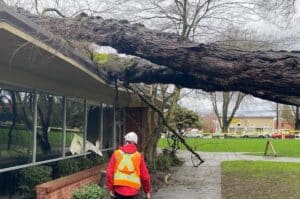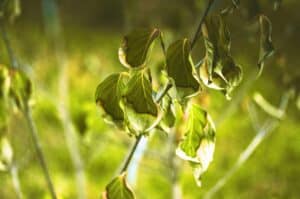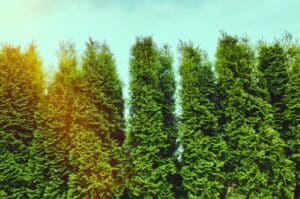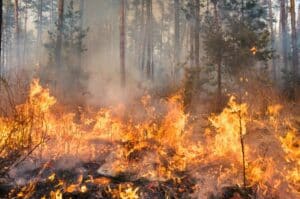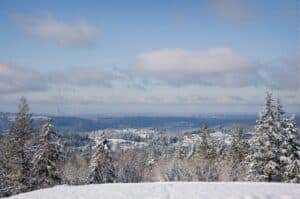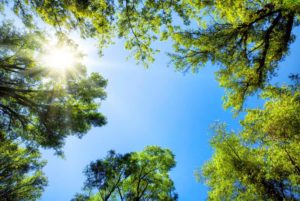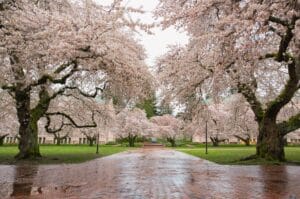Winter Tree Safety Tips from Your Seattle Tree Care Arborists
Safety during Seattle’s storm season starts with prevention. A fallen branch could seriously injure someone and it can also hurt your home by falling on your roof, breaking through your window, or knocking down your gutters. Every tree is different. Some types of trees are quick growing, which can mean
Winter tree safety during Seattle’s storm season starts with prevention. A fallen branch could seriously injure someone and it can also hurt your home by falling on your roof, breaking through your window, or knocking down your gutters.
Every tree is different. Some types of trees are quick growing, which can mean weaker wood leading to more storm damage. Tree size and age typically go hand in hand, so consider how great a threat your tree poses based on its size and placement on your property.
It’s important to have a reputable tree service company you can contact immediately in case of a tree emergency. Seattle Tree Care has an Emergency Response Arborist team available 24/7.
If you have trees near your home, especially large trees, it’s always a good idea to prepare for our region’s wet and windy weather. Whether it’s fallen branches or high winds knocking over trees entirely, keeping safe is essential. You can help ensure that your trees and property are safe by performing an inspection.
Performing a Winter Tree Safety Inspection at Home
When assessing your tree start by standing back and looking from a distance. Begin with the base of the tree and scan upward and make sure there is not a hazard present before you approach the tree.
Here’s what to look at when doing a home assessment of your trees:
- The branches
- The trunk
- The roots
Branches
Over-extended limbs can gather huge amounts of snow and could pose a problem. Always be sure to address trees that are over walkways and paths.
Look for dead limbs, typically easier to spot, but also keep your eyes peeled for any broken or cracked branches.
Trunk
Take a look at the trunk and look for cracks or any splitting.
If your tree has one or more co-dominant stems (trunks) it’s best to look at them before the
storm to assess whether their connection points look strong, and then again after the storm to check that for any separation of the trunks.
If your tree has a lean to it, take note of its position prior to the storm. Most likely your tree has grown at an angle and has self-corrected, and does not pose any significantly greater risk of failure than any other tree. If the lean appears to have increased after a storm, take a look at the ground around the base of the tree on the opposite side of the lean.
The Roots
If the soil is uplifting, it’s time to call an arborist to come perform a professional assessment.
Seeking professional help from a Certified Arborist can mitigate the risk posed by your tree, and a little work and care can prevent a massive headache after a large storm.
Protect with Proactive Pruning
The best way to keep your home and family protected is with routine tree trimming to address problematic branches or trunk damage.
Selective pruning of dead and weakly-attached limbs can prevent failure to cars, pedestrians, and your house. If your tree has a lean, consider end-weight reduction pruning to correct its symmetry, and reduce the chance of whole tree failure when the snow piles up.
Wood Chips to the Rescue!
Soil can become oversaturated with increased rainfall and snowfall, impacting root and trunk stability. Placing wood chips or another type of mulch around the base of your trees can reduce soil saturation and help your trees stay standing.
Removal: The Last Resort
While this is often the least desirable outcome, removal is always an option to eliminate risk to your property. Consider creating a wildlife snag to reduce risks to your property while still retaining a habitat for wildlife.
Let Us Do the Heavy Lifting
The key to tree longevity and health is working with a professional Arborist who knows the trees in Seattle and surrounding areas. Together, we can keep our urban trees safe and our infrastructure clear of debris Seattle Tree Care is a registered tree service company with the Seattle Department Of Construction and Inspection (SDCI). One of the requirements of this registration is to perform all tree work to ANSI A300 standards.
Arborists adhering to the ANSI A300 pruning standard will not:
- Leave branch stubs
- Make unnecessary heading cuts
- Cut off the branch collar (not make a flush cut)
- Top or “lion’s tail” trees (stripping a branch from the inside leaving foliage just at the ends)
- Remove more than 25% of the foliage of a single branch
- Remove more than 25% of the total tree foliage in a single year
- Damage other parts of the tree during pruning
- Use wound paint
- Prune without a good reason
- Climb the tree with climbing spikes
- Always find a professional tree care company
- A professional arborist can carefully assess your trees and work with you to determine the best and safest course of action for any work that needs to be done.
About Seattle Tree Care
For the past fifteen years, Seattle Tree Care has been passionately caring for Seattle’s urban canopy with tree trimming and tree removal services. Seattle Tree Care has a highly skilled Arborist team and is committed to providing exceptional customer service.
SEE MORE ARTICLES FROM OUR b(LOG)
We've got you covered with tips, resources, updates, how-to's, and other helpful information about trees and landscapes in Seattle, Puget Sound, and King County, WA. Join the thousands of smart local residents who get the monthly newsletter from Seattle Tree Care for helpful information you won't want to miss!
There's no spam - we promise! We are committed to keeping your e-mail address confidential. We do not sell, rent, or lease our contact data or lists to third parties.


